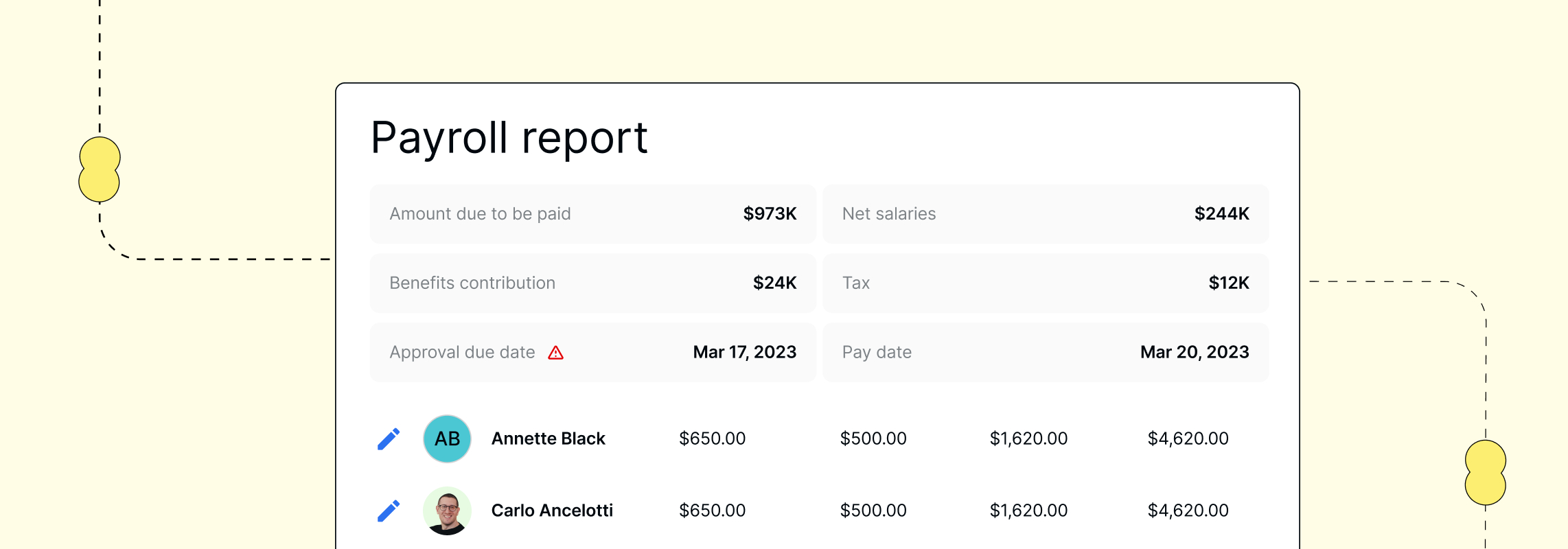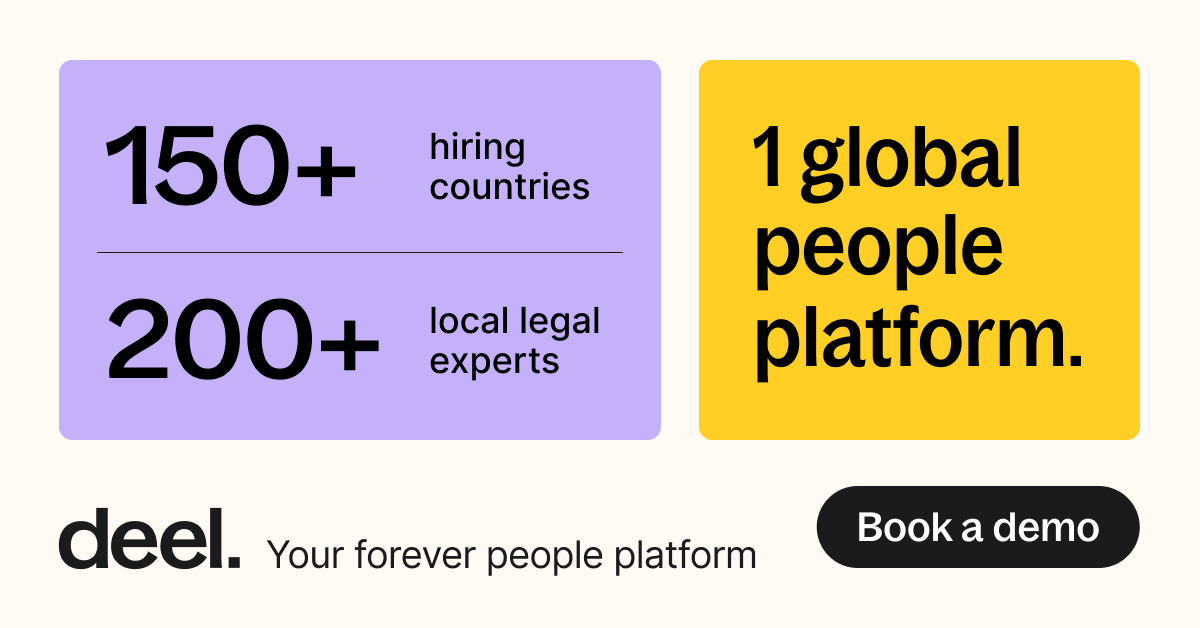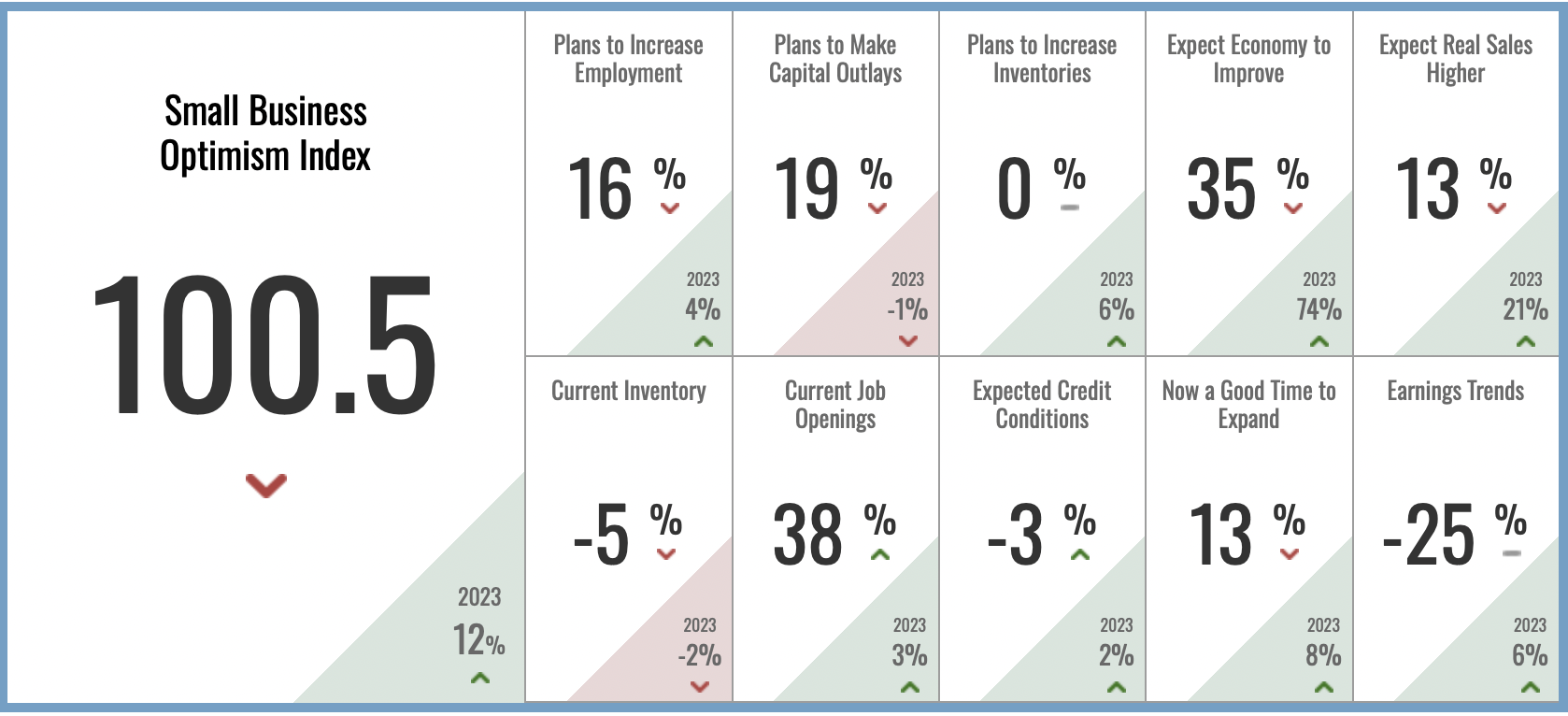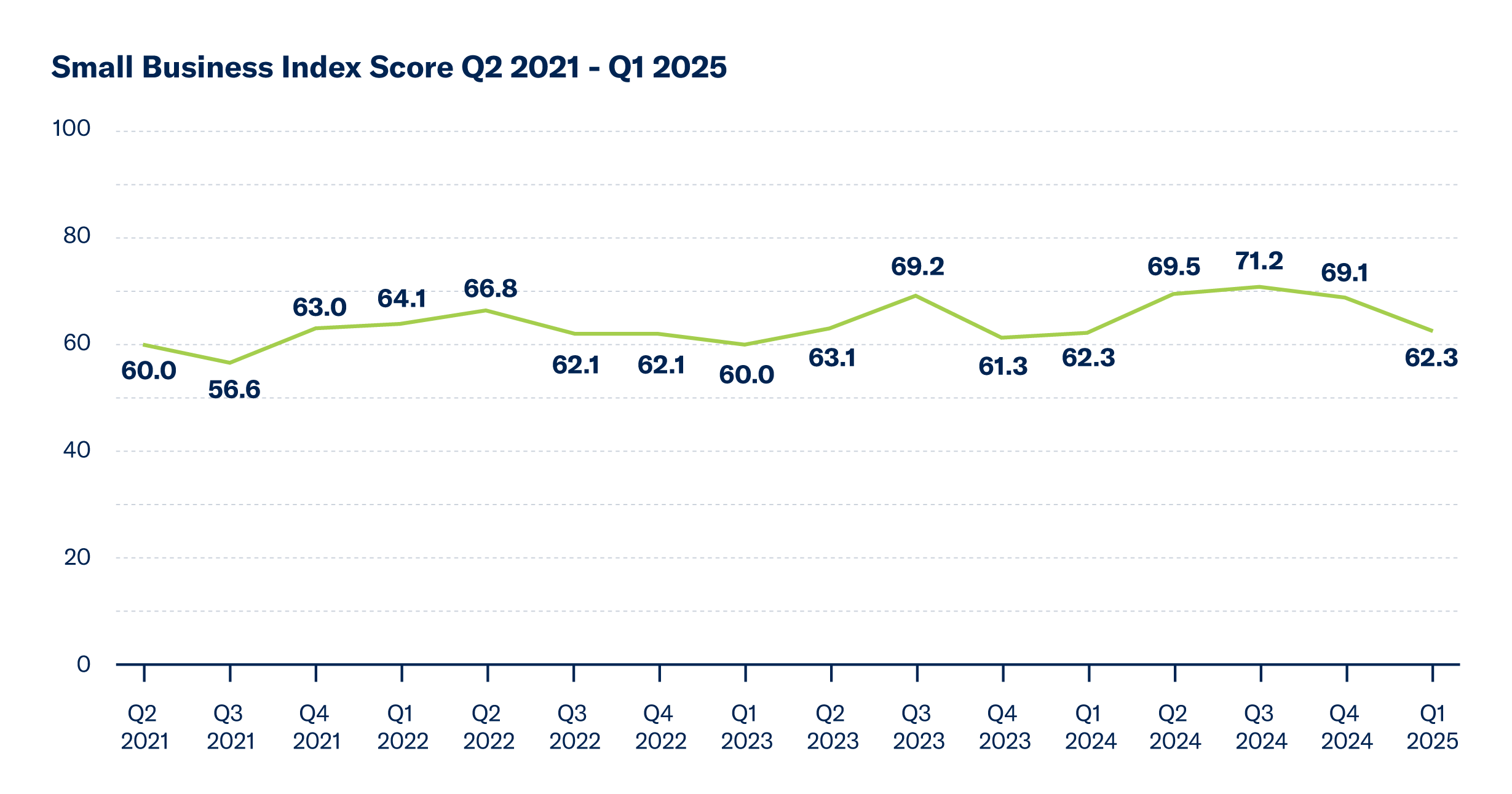The sweeping tariffs recently announced by the Trump administration will reshape the domestic and global business environment for years to come. Small businesses clearly will be impacted by this transformative shift in trade and economic policy. However, these businesses remain the backbone of the American economy, showcasing remarkable resilience and adaptability despite ongoing economic challenges. In this article, we highlight the resilient spirit of American small business through the lens of six key small business indices. We analyze the indices, examining current trends, challenges, and key drivers shaping the small business landscape for 2025. We’ll also explore how Professional Employer Organizations (PEOs) from leading players such as Deel help companies stay flexible, optimize their workforce strategies, and boost competitiveness. Be sure to follow us on LinkedIn. Now let’s get started.
Disclosure: At ClearSky 2100, our portfolio partly consists of affiliate partnerships. We may earn a small commission from buying links on our site at no cost to you.
A Course Correction Expected in 2H 2025
We expect small business growth in 2H 2025 to improve as economic and US political ecosystems recalibrate and normalize from the attempted pivot on trade and economic policy. First quarter 2025 insights from key small business indices suggest a shift to uncertainty from optimism among business owners across the United States. Nevertheless, slivers of optimism remain, with modest expansion planned in certain markets. An aggressive tariff policy, weaker manufacturing confidence, rising inflation, market uncertainty, and stale job market data all have created an upside bias toward recession risk. We see strong headwinds over the coming quarters. What’s clear is that in these uncertain times, workforce flexibility and workflow optimization are key to business survival.
Small Business Growth and Economic Impact
The United States has witnessed an extraordinary surge in small business formations, marking a significant shift in entrepreneurial activity. According to the U.S. Census Bureau, new business applications reached unprecedented levels, with over 5.4 million new business applications filed during 2023, surpassing previous records. This remarkable growth extends beyond statistics, translating into tangible economic benefits and job creation across diverse sectors and geographic regions. Between 2013 and 2023, small businesses (firms with less than 250 employees) accounted for 55% of the net job creation. Additionally, they represent roughly 44% of the nation’s gross domestic product (GDP). We expect this growth to continue for the foreseeable future irrespective of the current business sentiment.
Tariffs, Trump 2.0, and Impact on Small Businesses
On April 2, 2025, the Trump administration imposed a sweeping set of tariffs on the world economy. These new tariffs expand on the initial set of tariffs placed on Canada and Mexico as well as China on a range of sectors, including auto manufacturing, energy, and agriculture.
Many countries and trading blocs, including the EU, Mexico, China, and Canada, have announced plans to retaliate, setting the stage for a prolonged trade war or shortened negotiations. Others are taking a wait-and-see posture. Mexico and Canada are signatories to the USMCA, one of the world’s largest trade blocs. Most (99%) of the trade between the bloc members enjoys zero tariffs, with some carve-outs for agricultural products. The first joint review of the agreement will take place on July 1st, 2026.
The underlying objective for the tariffs is to revitalize American manufacturing. However, technological advancements, a rapidly aging population, aggressive immigration policy, and Global South development will create headwinds in implementation. Additionally, these policies are likely to accelerate geoeconomic realignment and multipolarism. We think the current swing in stakeholder sentiment is overblown and expect a course correction in the second half of 2025.
Downgrading Biden-Era Infrastructure Spending
Large-ticket spending programs enacted during the Biden administration, e.g., the CHIPS and Science Act, are under threat as the administration shifts focus to other priorities. As we’ve seen from the new tariff announcements, the first 12 months of the new administration will remain challenging as the focus is on personalities rather than policies and limited ability to prioritize the economy over ideology.

Economic Growth Forecasts
National Growth
- The GDPNow model from the Atlanta Fed now expects a 3.7% contraction in 1Q 2025. These forecasts represent further weakening from the March 28th contraction forecasts of 2.8%. With the implementation of the tariffs, economists now place the odds of a recession at over 50%. Goldman Sachs, pre-tariff announcement, had raised its estimate of a US recession to 35% from 20%. Additionally, JP Morgan has raised its odds of a recession to 60%. Traders expect at least four rate cuts in 2025 to address economic challenges.
Regional Economic Growth
- The broad demographic trends underway in the US will continue to drive regional economic performance in the medium to long term. The Sunbelt will remain a major beneficiary at the expense of the Northeast and Midwest as more populations migrate to Southern states. However, in the near term, regional economic performance remains mixed. According to global financial services firm Visa, regional GDP growth in the South and the Northeast is expected to trend above national averages through 2026. Regional economic activity in the Midwest will remain well below the national average, with a deceleration of economic performance toward national averages in the Western US. How these forecasts change remains a function of the effects of the tariffs.
We expect small business growth in 2H 2025 to improve as economic and political ecosystems recalibrate and normalize.
Small Business Sectors to Benefit Under Trump
Sectors Poised for Growth
- Manufacturing: Heightened tariffs on China and Europe aim to revitalize domestic production, benefiting small manufacturers. The potential benefit to these sectors may be offset by changes to Biden-era spending programs.
- Energy: Deregulation and expanded support for fossil fuels could boost opportunities for small energy firms. However, these opportunities need to be weighed in the context of supply-demand fundamentals and the $68/barrel oil price required to justify US production.
- Construction: The risk of repeal or reduction of Biden-era spending policies and labor challenges from ongoing immigration policies will be offset by increased demand from FDI and reshoring initiatives.
Challenges for Certain Sectors
- Retail: Higher tariffs may increase costs for small businesses reliant on imported goods.
- Agriculture: Export-dependent farms might struggle with retaliatory tariffs from trading partners.
Significant Opportunities but Rising Risk
Whatever side of the tariff debate you sit on, what’s clear is that global uncertainty is rising. For small businesses, the trade-off between localized growth and increased operational costs will shape strategic decision-making.
To mitigate the near-term impact from tariffs, we recommend small businesses explore a megaregion strategy to capitalize on emerging domestic growth opportunities. Additionally, international opportunities through M&A and other market entry strategies will create new opportunities for growth.
Over the next several years, we believe that rational economic behavior and political calculus will eclipse ideology, leading to a prioritization of domestic development and growth. Overall, the administration’s economic vision prioritizes domestic economic strength, creating a mixed but opportunity-rich landscape for small businesses.
Business Formation Trends
Business Formation Statistics (BFS) from the Census Bureau serves as a crucial economic indicator by tracking new business creation through four key measurements.
- Business Applications (BA) represent all new business registrations.
- High-Propensity Business Applications (HBA) identify registrations with a higher likelihood of becoming active businesses.
- Business Applications with Planned Wages (WBA) tracks entities planning to hire employees.
- Corporate Business Applications (CBA) monitors corporate legal structures.
Together, these metrics provide valuable insights into entrepreneurial activity and potential job creation across the U.S. economy.
The Business Formation Statistics (BFS) are an economic series provided by the U.S. Census Bureau in collaboration with the Board of Governors of the Federal Reserve System, offering insights into entrepreneurial and startup activity based on EIN and payroll data.
Strong Business Formation in February 2025
The U.S. Census Bureau’s Business Formation Statistics for February 2025 reveal a significant uptick in entrepreneurial activity. Overall business applications experienced a substantial 7.8% increase from the previous month, signaling heightened interest in forming new businesses. Moreover, projections for business formations within the next four quarters also saw a robust rise of 10.2%, indicating a promising outlook for startup creation. Regionally, the Midwest stood out with the highest percentage increase in both business applications and projected formations, demonstrating exceptional growth. The South also exhibited strong performance in these metrics. Climate and work stoppages in 2024 were absent at the beginning of 2025. We expect the growth trend to continue.
Key Indicators of Small Business Optimism
Despite the near-term concern among small business owners, there remains an undercurrent of optimism. The risk of tariffs remained top of mind for small business owners. Understanding the health and trajectory of the small business sector requires careful analysis of several key indices that track different aspects of small business performance and sentiment. We’ve pulled together six key small business indices assessing current performance and future outlook. While these were published before the Trump tariff announcement, they remain crucial barometers for measuring small business vitality across the United States.
NFIB Small Business Index Component Levels & YoY Change
NFIB Small Business Optimism Index
History and Methodology
Established in 1974, the National Federation of Independent Business (NFIB) Small Business Optimism Index stands as the longest-running and most comprehensive indicator of small business sentiment in the United States. The index surveys approximately 1,800 small business owners monthly across ten key components, including hiring plans, capital outlay, and sales expectations. This historical depth provides invaluable context for understanding long-term trends in small business confidence.
Current Analysis
- Index Remains High: The NFIB Small Business Optimism Index decreased to 100.7, 4.4 percentage points from its peak in December 2024, but still remains above the 51-year average.
- Increasing Uncertainty: Small business owners are facing high levels of uncertainty.
- Decreased Economic Optimism: Only 37% of owners expect the economy to improve, down 10 percentage points from January. Additionally, 12% of owners felt it was a good time to expand, down five percentage points from January.
- Labor Quality Top Concern: Labor quality has surpassed inflation as the biggest problem for small businesses.
- Significant Job Openings: A seasonally adjusted 38% of owners reported unfilled job openings.
- Rising Prices: A net percentage of owners raised average selling prices, and more plan to do so in the near term.
- Negative Sales: A net negative percentage of owners reported higher nominal sales in the past three months.
- Slightly Tighter Credit: A net percentage of owners found their last loan harder to obtain.
- Business Health Mixed: Owners reported their business health as 11% excellent, 55% good, 27% okay, and 6% bad.
Outlook
The NFIB Small Business Index suggests a slight dip in optimism but remains at a relatively high level. However, the high uncertainty and decreasing expectations for economic improvement indicate potential caution among small business owners. The focus shifting to labor quality as the top problem highlights ongoing challenges in the workforce. While prices are rising, recent sales figures are negative, which could signal future challenges. Access to credit is also perceived as slightly more difficult.
According to the NFIB’s 2024 Small Business Problems and Priorities report, the cost of health insurance remains the #1 concern for small businesses. It has remained the top concern for the past 37 years.
MetLife & U.S. Chamber of Commerce Small Business Index
History and Methodology
Launched in 2017, this quarterly index provides detailed insights into small business perspectives and operations, with a particular focus on local economic health, business environment, and cash flow expectations. The sample criteria are businesses with fewer than 500 employees that are not sole proprietorships. Additionally, the index incorporates data from Ipsos and employs a sophisticated methodology that captures both current conditions and future expectations.
Current Analysis
- Index Declines: The Small Business Index stands at 62.3 in Q1 2025, down from 69.1 in the previous quarter, matching the reading from a year ago.
- Slight Dip in Business Health: There’s a slight decrease across measures of business health, cash flow, and staff increases.
- Stable Economic Views: Small businesses’ views of the U.S. and local economies remain stable.
- Inflation is Top Concern: Inflation continues to be the primary concern for small business owners, reaching record high levels.
- Rising Revenue Concerns: Concerns regarding revenue have also increased among small businesses.
- Hiring Focus: Businesses seek leadership and internship experience in entry-level employees, favoring trade schools for worker preparedness.
- Pay Transparency Trend: There’s a growing trend towards including pay information in job descriptions, particularly among younger business owners.
The MetLife US Chamber Small Business Index Score
Outlook
The outlook suggests a slight cooling in small business confidence compared to the previous quarter, though it remains at the same level as last year. While views on the overall economy are stable, the persistent and increasing worry about inflation and rising concerns about revenue indicate potential headwinds for small businesses in the near term. The focus on specific skills in hiring and the trend towards pay transparency reflect an evolving labor market for small businesses.
Fiserv Small Business Index
History and Methodology
Introduced in 2020, the Fiserv Small Business Index takes a unique approach by analyzing actual transaction data rather than survey responses. This methodology provides real-time insights into small business performance through direct measurement of business transactions and spending patterns.
Current Analysis
The Fiserv Small Business Index rose to 150 in March 2025, up 1.8% from the prior month’s number, a 5.5% YoY increase. The index shows year-over-year sales growth of 1.8% and strong consumer transaction growth of 4.0%. Notably, healthcare providers and trade contractors demonstrated particular strength, with growth rates of 4.7% and 2.8%, respectively.
- Positive Sales Growth: Small business sales saw a year-over-year increase of 5.1% in January and 2.1% in February 2025. Month-over-month growth was 0.5% in January and 0.1% in February.
- Strong Transaction Volume: Total transactions showed healthy year-over-year growth (6.5% in January and 4.0% in February) and month-over-month growth (1.3% in January and 1.6% in February).
- Sector-Specific Strengths: The Food Services and Drinking Places category remained strong in January, while retail and restaurants performed well in February.
- Slightly Slower Growth Rate: The combined sales growth for the first two months of 2025 is slightly lower compared to the same period in 2024.
- Lower Average Ticket Size: While transactions are up, the average amount spent per transaction has decreased.
- Strong Sales Growth Nationwide. 44 of the 50 states registered sales growth, with South Carolina (13.4%), North Dakota (13.3%), and North Carolina (12.4%) registering the strongest year-on-year growth, respectively. While Illinois (5.7%), Ohio (5.3%), and West Virginia (5.1%) registered the strongest month-on-month growth, respectively.
Outlook
The Fiserv Small Business Index indicates a continued positive trajectory for small business sales in early 2025, driven by resilient consumer spending. However, the slightly slower growth rate compared to the previous year and the trend of lower average ticket sizes suggest a need for cautious optimism. While transaction volume remains strong, businesses may need to focus on strategies to maintain or increase the average spending per customer.
CNBC|Survey Monkey Small Business Confidence Index
History and Methodology
The CNBC|SurveyMonkey Small Business Confidence Index was established in 2017 to gauge the sentiment of small business owners in the United States. The survey covers 10 key questions related to views of the economy, hiring, investment, and other economic indicators.
Current Analysis
- Mixed Confidence: Small business confidence shows a balance, with an index of 56. While 39% are optimistic about the economy, inflation (24%) remains a top concern.
- Positive Business Fundamentals: Sentiment is positive regarding current business conditions, expected future revenue, anticipated employment levels, and the impact of technological innovation.
- Policy Concerns: There’s mixed to negative sentiment concerning government regulations, trade policy, and immigration policy.
- DEI Adoption: Over half of small businesses have adopted DEI practices, reporting a positive impact.
- TikTok Ban: Most are unaffected by a potential TikTok ban, though nearly half support it.
- Partisan Divisions: Opinions on mass deportations and tariffs are split along party lines.
The underlying objective for the tariffs is to revitalize American manufacturing. However, technological advancements, a rapidly aging population, aggressive immigration policy, and Global South development will create headwinds in implementation
Outlook
The outlook for small businesses in early 2025 is a blend of optimism in core business areas tempered by anxieties related to the broader policy environment and persistent inflation. While positive about their own operations and technological advancements, small business owners are wary of government actions and trade dynamics.
Vistage Wall Street Journal Small Business Index
History and Methodology
The WSJ/Vistage Small Business CEO Confidence Index, launched in 2012, is calculated based on responses to six questions concerning the current and anticipated state of the U.S. economy, projections for revenue and profitability, and plans for hiring and investment. The index is based on a survey of CEOs and other key leaders who are active U.S. Vistage members.
Current Analysis
- Confidence Declining: The index fell to 85.4, marking the third consecutive monthly drop, signaling a consistent negative trend in CEO sentiment.
- Rising Economic Pessimism: Small businesses are increasingly pessimistic about both current (42% report worsening conditions) and future (only 27% optimistic) U.S. economic conditions. More expect the economy to worsen (43%).
- Tariffs Eroding Confidence: Tariffs continue to negatively impact sentiment, with 64% expecting adverse effects and only 8% anticipating benefits.
- Lower Revenue & Profit Expectations: Fewer businesses expect revenue growth (59%), and profitability expectations have fallen below half (47%), with more anticipating a decline (21%).
- Cautious Hiring & Investment: Hiring plans are stable (48% plan to add staff), but more are considering reductions (12%). Investment plans show a slight uptick in increases (36%), but also a rise in planned decreases (16%).
Outlook
The outlook is marked by growing uncertainty and concern among small business leaders. Post-election optimism has reversed due to worries about economic conditions and the negative impact of tariffs, suggesting a cautious approach and potential growth slowdown indicated by declining revenue and profit expectations and a rise in planned workforce reductions.
Goldman Sachs 10,000 Small Business Voices
History and Methodology
The Goldman Sachs 10,000 Small Businesses Voices initiative was launched more recently, in April 2020. This initiative was specifically created to help small business owners across the country organize and advocate for policies that are important to them. The methodology includes a survey of 1,188 Goldman Sachs 10,000 Small Businesses participants conducted by Babson College and David Binder Research. The survey included small business owners from 49 U.S. states, 2 U.S. territories, and the District of Columbia.
Current Analysis
The current outlook for small businesses in 2025 is one of optimism, with many owners anticipating growth and planning to hire.
However, this optimism is tempered by significant challenges, including:
- Persistent Economic Headwinds: Small businesses continue to grapple with economic challenges, particularly in hiring qualified employees due to competition from larger companies, a shortage of skilled workers, and high labor costs. Many struggle to offer competitive benefits. Roughly 89% of small businesses hiring are finding it difficult to recruit qualified employees.
- Access to Capital: Securing affordable capital remains a major hurdle, with high interest rates hindering loan accessibility for many small businesses.
- Government Support Tailored to Small Businesses: There’s a call for the federal government to better understand and cater to the unique needs of small businesses through targeted programs and services.
- Tax Reform: Small business owners find the current federal tax system unfavorable and advocate for simplification and better incentives.
- Embracing AI with Support: Many small businesses, 60%, are using AI for efficiency gains and better data for decision-making. However, 44% of small business owners indicate they often lack the necessary resources and expertise, highlighting a need for government support in technology adoption.
Outlook
In summary, while small business owners are positive about the coming year, they emphasize the need for government intervention and policy changes to address ongoing challenges related to workforce, capital, regulations, and technology adoption to ensure sustained growth and competitiveness.

Summary of Index Findings
Consolidating the results from the six indices, key trends are emerging. While many of these observations are recorded before the tariff announcements, they do reflect underlying structural elements and longer themes of small business across the US. Some of these trends include
Overall Sentiment Remains Mildly Positive
Despite some near-term concerns, there is an underlying optimism among small business owners, though down from 2024 levels.
Persistent Challenges
- Rising prices continue to be a primary concern for many small business owners.
- Challenges in finding and retaining qualified workers persist, impacting growth.
- Economic uncertainty remains a significant factor for small businesses.
Signs of Resilience
- Many small businesses anticipate positive revenue growth.
- Hiring intentions continue to show strength across the sector.
- Plans for capital investments remain generally stable despite ongoing challenges.
Regional and Sector Variations
- Certain sectors, such as healthcare providers and trade contractors, have demonstrated particular strength.
Forward-Looking Indicators
- Plans for business expansion remain cautiously optimistic among owners.
- Investment intentions suggest a continued focus on growth.
- Hiring plans indicate confidence in future demand for goods and services.

Supply Chain Resilience Driving New Opportunities
The global supply chain disruptions experienced during the pandemic have been replaced by geopolitical risks and global economic uncertainty. Conflict in Europe and the Middle East and concerns in Asia-Pacific are causing unease among companies dependent on global supply chains. These bottlenecks have created challenges in transit times, costs, and availability. For example, the current conflict in the Red Sea has added an additional 14 days in transit times and an average cost increase of 1 million USD per trip.
Between 2010 and 2023, it took 11 years to add the first million reshoring jobs but only 3 years to add the second million.
Manufacturing restructuring efforts have created particularly robust opportunities for small businesses. The Reshoring Initiative reports that 2023 saw record levels of reshoring and foreign direct investment (FDI) announcements, with over 285,000 manufacturing jobs returning to or being created in the United States. Small businesses are benefiting both as direct manufacturers and as crucial suppliers to larger reshored operations. Component manufacturers, precision machining shops, and specialized industrial service providers are experiencing increased demand as larger manufacturers seek to establish reliable domestic supply networks.
The aggressive tariff posture by the Trump administration is upending well-established supply chains, forcing businesses to find solutions to hedge supply chain risk.
New Small Business Opportunities
Technology and automation have become crucial enablers for small businesses participating in reshored manufacturing. Small manufacturers are investing in advanced manufacturing technologies, including 3D printing, robotics, and Industrial Internet of Things (IIoT) capabilities. This technological adoption, often supported by federal and state grants, allows small businesses to compete effectively in terms of both cost and quality while maintaining domestic operations.
Closing the Skills Gap
Labor force development has emerged as a critical component of successful reshoring, creating opportunities for small businesses in training and workforce strategies. Additionally, trade schools have seen a resurgence as students eschew community colleges and four-year institutions. Enrollment in trade schools grew 4.9% between 2020 and 2023. Major growth areas include:
- Culinary Arts: 13.4%
- Beauty and Wellness +3.4%
- Healthcare +3.3%
- Specialty trade +0.1%
Small businesses are partnering with community colleges and technical schools to develop training programs, creating additional revenue streams while helping to address the skilled labor shortage in manufacturing. According to estimates, there are an estimated 2.1 million jobs that could go unfilled by 2030.

Evolving Small Business Priorities and Challenges
Tariffs aside, the American small business landscape is rapidly evolving. As such, the issues and priorities of small business owners also continue to evolve. In 2020, the unique challenges of the pandemic drove concerns among small business owners. In 2024, while some issues and concerns carried over from 2020, the current economic environment has changed priorities. The implementation of major tariffs brings a new set of challenges in 2025. However, the tariff issue, while transitory, has exacerbated many of the underlying issues small businesses face.
According to the NFIB’s 2024 Small Business Problems and Priorities report, the cost of health insurance remains the #1 concern for small businesses. It should be noted that the data does not include the impact of tariffs; however, many of these issues will be magnified as a result of the new trade and economic policies of the Trump administration. Nevertheless, health care It has remained the top concern since 1986. Based on the 2024 NFIB report, the top 10 small business concerns nationwide, several of which are workforce-related, include:
- Cost of Health Insurance: This key concern has remained the top issue for small businesses for the past 37 years. About 41% of respondents deemed it critical in 2024.
- Cost of Supplies/Inventories: This concern rose significantly in severity from 12th place in 2020 to 2nd place in 2024, likely due to inflation and supply chain disruptions post-pandemic. Roughly 20% of owners found this issue critical.
- Uncertainty over Economic Conditions: This concern jumped from 9th place in 2020 to 3rd place in 2024, highlighting the economic volatility small businesses face. About 22% of owners found it critical.
- Federal Taxes on Business Income: Taxes consistently rank among the top concerns. 25% of respondents found federal business income taxes a critical problem in 2024.
- Locating Qualified Employees: Finding skilled workers continues to be a major challenge for small businesses, though the severity of this issue declined slightly from 2nd place in 2020 to 5th place in 2024. 28% of owners found it critical.
- Cost of Natural Gas, Propane, Gasoline, Diesel, and Fuel Oil: Rising energy costs pushed this concern up significantly from 19th place in 2020 to 6th place in 2024. 24% of respondents found it critical.
- Unreasonable Government Regulations: The overall severity of this concern declined slightly, moving from 6th place in 2020 to 7th in 2024. However, it remains a significant worry for 24% of small businesses who consider it critical.
- Uncertainty over Government Actions: Policy uncertainty remains a significant concern for small businesses. This concern rose in severity from 2020 to 2024, ranking 8th. About 23% of owners found it critical.
- State Taxes on Business Income: This concern fell slightly in ranking from 7th place in 2020 to 9th place in 2024. Roughly 22% of owners found it critical.
- Electricity Costs (rates): High energy costs remain a concern for small businesses. About 16% of owners found this issue critical.
Workforce Issues Remain Prevalent in Key Sectors
Across several sectors, labor issues remain front and center as the US contends with a skills gap and rapid demographic shift toward an aging population. The sectors with major workforce challenges are
- Construction: This sector consistently reports the most acute labor challenges. “Locating Qualified Employees” ranks as the second most severe problem for construction, with 35% of owners finding it “critical. Additionally, ” The difficulty in “Finding and Keeping Skilled Employees” is also significant, with 33% rating it as “critical.” Employee Turnover is also more pronounced in construction compared to the overall average. This sector also reports the highest concern regarding Undocumented Workers among all industries.
- Manufacturing: While not as severe as in construction, manufacturing also faces difficulties with labor. Given the ramp up in US manufacturing and the expected demand for jobs, “Training Employees” and “Managing Employees” rank higher in concern for manufacturing compared to the overall small business population. This suggests challenges in finding workers with the right skills and in managing workforce performance.
- Professional Services: Fields like legal, engineering, accounting, and health services, experiences a higher level of concern with “Training Employees” compared to the overall average. This suggests a need for ongoing professional development and specialized skills within these fields.
The Role of PEOs in Addressing Workforce Challenges
Professional Employer Organizations (PEOs) have emerged as a crucial solution for small businesses navigating these complex workforce challenges. PEOs offer comprehensive employment solutions that are particularly valuable in the current economic environment.
PEOs can be particularly valuable in tight or uncertain labor markets for several reasons:
- Enhanced Benefits Packages: PEOs pool employees from multiple companies to negotiate better rates on health insurance and benefits. This helps smaller companies compete with larger employers for talent. These benefits e.g.,(401k, dental, vision, etc.) would be too expensive individually.
- Reduced Administrative Burden: These organizations handle payroll, compliance, and HR administration. Removal of this administrative burden allows your organization to focus resources on core business and recruitment. This can be particularly valuable when HR staff are hard to find or retain.
- Risk Management: PEOs share employer liability, ensuring compliance with employment laws. This is particularly important in competitive markets where misclassification and other mistakes can be costly.

Deel PEO: A Comprehensive Solution for Growing Businesses
Given the growth potential but real challenges facing small business owners, Deel emerges as a unique player. Deel ranks as the leading all-in-one global HR platform that supports companies with contractors or direct employees. The Deel advantage includes
- Streamlined global payroll in over 150 countries
- Access to global talent pools
- Advanced HR information systems
- Integrated payroll and benefits systems
- Comprehensive Immigration Services
Addressing Small Business Workforce Challenges
For small businesses in key sectors with acute workforce challenges, Deel US PEO and Payroll Services addresses the needs of businesses, offering a range of services designed to simplify HR management in the US or abroad. Additionally, the company allows businesses to seamlessly combine payroll and benefits, supporting the ability to handle a range of HR issues from state tax compliance to terminations and worker claims. Key advantages to Deel’s platform include:
- Access to economies of scale for company benefits and benefits administration.
- Deel HR to manage your entire workforce: Deel HR is a free service for companies with less than 200 employees.
- Training, HR policies, and on-demand HR support
- Advanced tax and benefit compliance
Other benefits of partnering with Deel include
Deel Payroll Dashboard

- Nationwide Coverage: Deel serves employers in all 50 states across all industries with a team of in-house experts knowledgeable with federal, state, and local labor laws.
- Market-leading Leading service: Deel provides a dedicated CSM with a 24/7 in-app chat and a 1.25-minute FRT (First Response Time). It ensures quality support and the ability to have questions answered promptly.
- Security and Data Protection: Dell’s platform provides tight data security and protection. The company is SOC2 and ISO 27001 certified. They also offer GDPR-compliant solutions with the ability to integrate with multiple SSO providers.
For US small and medium enterprises (SMEs) expanding internationally or international SMEs seeking to enter the US markets, Deel offers benefits. Companies can take advantage of Deel’s global footprint (150+ countries) and variety of services, including Global Payroll and Employer of Record (EOR). Whether companies are seeking to expand into fast-growing US markets or take advantage of geoeconomic trends, e.g., nearshoring or reshoring, Deel can address your needs. Most importantly, Deel’s platform is flexible and designed around scaling and optimizing support as your business grows.
For small businesses seeking to implement or optimize their HR tech stack, the following guides below will help your team in their decision-making process.
- A Guide to PEO
- Global Sick Leave and Mental Health Day Template
- Guide to Running US Payroll
- The Global Hiring Toolkit
- A Guide to Choosing an HRIS for Your Business
Fleeting Optimism with Ongoing Structural Shifts
Finally, the 1st quarter of 2025 has brought about transformative changes in the US business landscape. The move to substantially reduce regulation, providing a growth environment for small businesses, has been a positive. However, the recent tariff announcements have created a seismic shift, upending globalization and decades-long trading relationships. Additionally, aggressive attempts to rightsize the federal workforce combined with moves to reform the US pension system add to the set of challenges faced by small businesses in the decades ahead.
Despite all the uncertainty, the small business sector continues to demonstrate unprecedented resilience and adaptability. We expect growth in business formation to continue into 2025, driven by economic opportunities and the drive toward worker independence. Based on the current small business indices, optimism remains, though fleeting. Sentiment post-tariff announcement will test the optimism of small businesses. However, in the medium to longer term, the convergence of federal investment, reshoring activity, technological advancement, and evolving consumer preferences creates favorable conditions for sustained small business success.
While challenges persist, particularly in workforce management and economic uncertainty, the fundamental strength of American small businesses suggests a bright future for this crucial contributor to the economy. The strategic use of PEO services, particularly market-leading solutions like Deel PEO, positions small businesses to capitalize on current opportunities while building sustainable operational foundations. Our belief in growth in the second half of 2025 reinforces the essential role of small businesses in driving economic prosperity and community development across the United States.
















